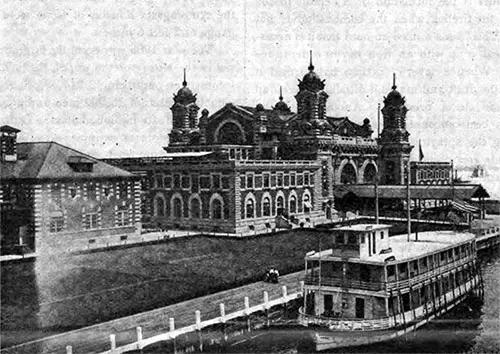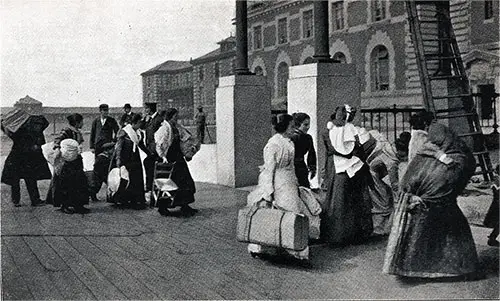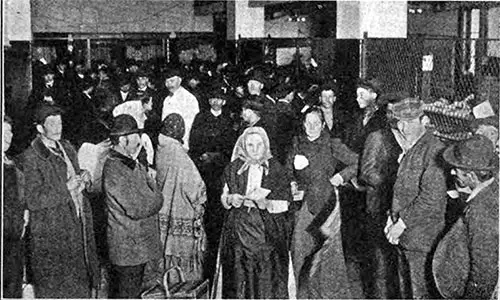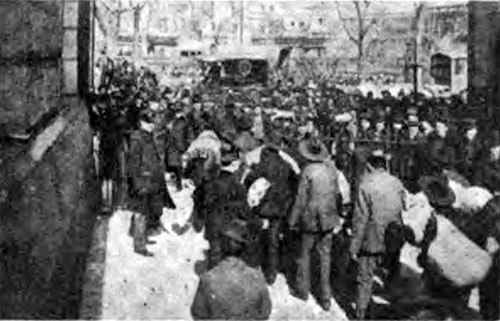The Gateway to America For European Immigrants - 1906

Ellis Island Immigrant Station -- One of the Small Barges in the Foreground. Commercial America, July 1906. GGA Image ID # 14f3d6a3a6
Working of a Receiving Station in which Five Thousand Immigrants may be Examined In a Single Day
By P. T. Cherington
One of the most noteworthy features of the industrial system in the United States is the question of labor supply. The efficiency of American labor has been the subject of an endless amount of discussion among students of industrial affairs.
A good deal has been said about national characteristics, and an attempt has been made to discover what might be called "an American type of workingman", but, as a matter of fact, the American workingman has, as yet, no well-defined national characteristics.
In a country so young as this, where a relatively small percentage of the population can go back for more than two generations without encountering alien ancestors, it is pretty early to begin to talk of a national type, either among working men or among any other classes.
The fact remains that the entire labor question in this country is still very intimately connected with the question of immigration. It is the importance of this question, and its close relation to American industrial life, that gives such interest to the work of the Bureau of Immigration of the Department of Commerce and Labor, and to the methods which that Bureau uses in attempting to exercise a reasonable amount of control over the stream of population which is constantly pouring into this country from abroad.
During the fiscal year ending Jane 30th 1905, the total number of immigrants admitted into the United States was 1,059,755. Of these 33,256 were aliens in transit, the remaining 1,026,499 being permanent additions to the country's population.
The great mass of these, of course, came from Europe, the total from European countries during the year having been 974,273. Of the European countries, Austria Hungary sent 275,693, Italy, including Sicily and Sardinia, 221,479, Russia, 184,897, and the United Kingdom, 134,631.
Of those coming from non-European countries, 23,925 came from Asia (nearly half being from Japan), 16,641 came from the West Indies, and the remainder in smaller numbers from other parts of the world.
About four-fifths of the total number of immigrants received in the United States every year enter through the port of New York, which gives the Immigrant Receiving Station, at Ellis Island, unusual importance in the immigration system of the country.
During the fiscal year ending June 30, 1905, 821,169 aliens entered the country through the port of New York, and during the fiscal year just ended approximately 880,000. Of the number entering in 1905, 98,000 were examined on shipboard, they being first cabin passengers.
This left a total of approximately 722,000, or, to be accurate, 722,741 aliens who passed through the receiving station at Ellis Island. Of this number, 715,663 were admitted, and 7,078 were deported.
These, together with 102 cabin passengers who were deported, made the total number of deportations 7,180. Aside from these aliens who were handled at Ellis Island, there were examined also by the receiving station 126,296 steamship passengers who presented unquestionable proof of citizenship.
In addition to the simple process of examining this great number of aliens for the purpose of eliminating those who would make undesirable citizens, there is an enormous amount of miscellaneous work to be done at the New York station.
Large numbers of each day's arrivals are, for various reasons, detained at Ellis Island for longer or shorter periods. All who are deported must be detained from one to two weeks pending the sailing of the next vessel of the line which brought them over.
Other immigrants must be provided for until relatives or friends can be communicated with, and others must be taken care of until arrangements can be made for sending them to their destination.
All these demands make it necessary that decent and comfortable accommodations shall be provided for a large and variable collection of people. During the time when they are kept at the station, these people must be fed, sheltered and furnished with beds, baths, etc., and their friends must be communicated with.
During the last fiscal year some 30,000 telegrams were sent out by the station, and as many were received in reply, in addition to 10,000 or more letters received and delivered.

Immigrants Walking from the Barge Landing to the Main Building at the Ellis Island Immigrant Station. Commercial America, July 1906. GGA Image ID # 14f42a4a6e
Moreover, some oversight must be exercised to prevent the money of ignorant aliens falling into the hands of dishonest persons, and this has necessitated the building up of what practically amounts to a banking system.
During the past year no less than 16,555 remittances, aggregating $260,891.85 were received for detained aliens, or for persons expected to arrive, and were carefully kept until they were delivered to the proper person.
The main building of the present receiving station at Ellis Island is a relatively new structure put up some three or four years ago to take the place uf the previous building which had been destroyed by fire.
The new station is a very handsome affair of brick, with stone trimmings, and while it was built to meet the requirements of the station for many years to come, it has already been necessary to plan for large extensions, which, it is hoped, will be added in the course of the next two or three years.
The main feature of the building is a large central receiving hall. This room extends through two floors. On the lower floor the room is divided up by means of railings and gratings into compartments, or alleyways, each of which is provided with rows of benches.
The second floor of the room consists of a wide gallery from which open off large sleeping rooms for the use of the immigrants. These sleeping rooms are provided with berths which consist of woven wire mattresses suspended in iron frameworks in tiers of two or three.
The sleeping rooms are built and equipped with a view to easy cleansing, and convenience in ventilation and sanitation. The floors are of cement and are so constructed that they can be readily flooded or thoroughly cleaned without injury.
At one end of the large receiving-hall is a room which is used for immigrants who are detained for detailed physical examination, and a suite of rooms for the use of the Board of Special Inquiry.
At the other end of the receiving-hall is a corresponding wing, which is divided into rooms for handling the immigrants who have passed the examination and are either temporarily detained or are ready to be sent to different parts of the country.
The main features of this wing of the building are great waiting-rooms, which look very much like the waiting-rooms of railway stations.
There are, also, smaller waiting-rooms where passengers who are about to depart for their destinations are grouped and kept ready, and there are a number of smaller rooms for banking purposes and for the supplying of railway tickets and paying remittances to the immigrants which have been received for them.
There is a separate wing which serves as the executive center of the institution, with offices for the principal officials, and at one side, adjoining the main waiting-room, is a long, low shed, which is used ss an eating-hall for feeding the immigrants.
When a Teasel carrying immigrants reaches New York harbor and has passed the preliminary inspection and the inspection of the quarantine officials, the immigrants are taken off on barges belonging to the Immigration Service, and these barges are brought to Ellis Island and tied up at a convenient landing stage immediately beside the station.
The immigrants, on landing, are passed at once to rooms in the lower floor of the building where they are grouped for convenience in examination. When the examining officials are ready the immigrants start in line np wide stairways leading into the main receiving-hall.
Near the head of the stairs stands the first of the medical inspectors, whose duty it is to examine each immigrant as to the condition of his head and scalp and for any general deformity.

Immigrants Getting Railroad Tickets at Ellis Island. Commerical America, July 1906. GGA Image ID # 14f43ff8eb
The immigrant next passes to the second inspector who examines him for any deformity of hands or feet, and for any evidence of scrofulous or tuberculous scars on the neck. The third inspector at the end of the inspectors' alley examines for any contagious, or evident difficulty with the eyes.
If the immigrant is so unfortunate as to fail to pass these three inspectors, or if he arouses the suspicions of any one of them, he is turned, at the end of the alley, to the special room, where he must wait for detailed examination. Should he pass the inspectors, however, he is at once turned to one of the narrow alleys lined with benches, where he awaits further examination.
The grouping of the immigrants in these alleys is done according to numbered tickets which correspond to the immigrant's number on the ship's manifest. When the immigrants enter the vessel in Europe, they are classed into groups of 30 and separate manifests, or lists, are made out for each group.
These manifests must give the name, sex, age, and the general description of each immigrant, together with his nationality, his point of departure, and his destination. It must also show something of his general character, including such questions as to whether he is a polygamist or anarchist, and whether he has ever been in any almshouse, insane asylum, or other charitable institution.
It must also show the approximate amount of money he has and must indicate pretty clearly whether he is in a position to make his own living after he reaches the country.
The immigrant, after being assigned to the proper alley, is brought before an inspector who puts him through an examination which is designed to check up the information which is given on the ship's manifest.
After this examination he is passed to the proper waiting-room, to which he goes by way of two or three other inspectors who give him an examination covering different features.
Those immigrants who expect to go direct to New York City, and to remain there, are sent to a special waiting-room, whence they are taken to New York on the Immigration Bureau ferry, "Ellis Island" and are landed at the famous barge office at Battery Park.
Those who are to be detained are put into the permanent waiting-room where they are afterwards cared for according to their needs. Ample accommodations are made for recreation, and the children's playrooms forms an interesting feature of the station's equipment.
The eating-room, which adjoins the main waiting-room, is a large hall fitted with plain tables and benches. Three meals a day are served for all the immigrants who are detained, these meals consisting of plain and substantial food, designed to give the greatest amount of nourishment at least practicable expense.
The cost of the maintenance of this department is provided for from the fines collected from the steamship companies for every undesirable immigrant imported, and from the head tax of $2.00, which is collected from the steamship company for every immigrant imported.
It is the object of the officials at the station to see to it that no immigrant leaves the Island until he has either some definite destination, some friend who can take care of him and see that he is properly initiated into the mysteries of his new home, or that he is guaranteed some protection from the host of scoundrels who are ready to separate the unsophisticated alien from the remnant of his savings.

Immigrants Pass Through the Barge Office Gate. Commercial America, July 1906. GGA Image ID # 14f45b928e
Those persons who fail to pass the physical examination are given a more thorough inspection, and if they are only temporarily ill, are sent to the hospital at one end of the grounds and are cared for until they are able to leave.
If their physical defects are such as to make it impossible to receive them under the law, they are isolated and are kept until they can be returned by the first steamer of the line which brought them over.
Those who are detained for special reasons, such as their political beliefs or moral undesirability are passed upon by a special Board of Inquiry, and if they fail to satisfy this Board that they are desirable immigrants, they are* deported in a manner entirely similar to that pursued with those who fail to pass the physical examination.
An interesting side of the immigration problem is the question of determining the ability and preparation of the immigrants to care for themselves.
Of the total, 13,643 belonged to the professional classes, 180,112 were skilled workmen, 600,726 were entered as being followers of what were classed as miscellaneous occupations, including 287,450 laborers, 142,187 farm laborers, and 125,473 servants.
The total number entered for the year having no occupation, including all children under 14 years of age, was 232,018.
One of the most difficult features of the entire situation is the tendency of immigrants to remain in the large cities. Over 65 per cent of the total number of immigrants received last year went to the four states of New York, Pennsylvania, Massachusetts, and Illinois, the greater part of these going to the four cities of New York, Philadelphia, Boston, and Chicago.
With these cities already seriously overburdened with what has been termed an "indigestible" alien population, while vast areas of western farming country are in serious need of energetic field hands, it has become a problem which demands all the ingenuity of the Immigration Bureau to devise some satisfactory method of diverting this stream of population from the points where it must do harm, both to the existing population and to itself, and sending it to the regions where the chances of leading clean and profitable lives, with the possibility of development into good citizens, are at least even.
P. T. Cherington, "Ellis Island," in Commercial America, Philadelphia: Philadelphia Commercial Museum, Vol. III, No. 1, July 1906, pp. 12-13.
